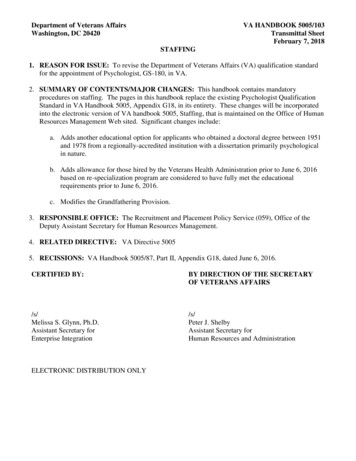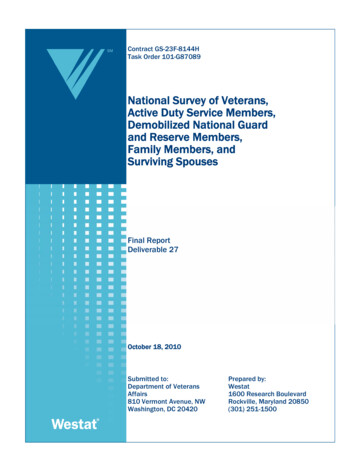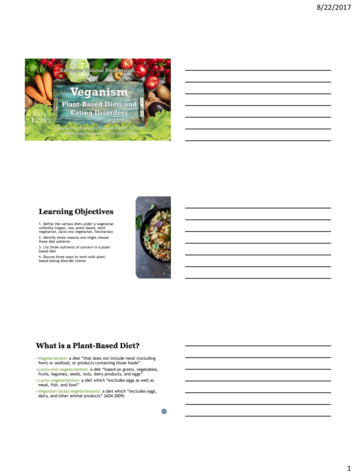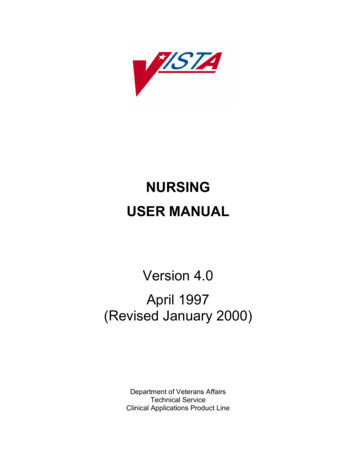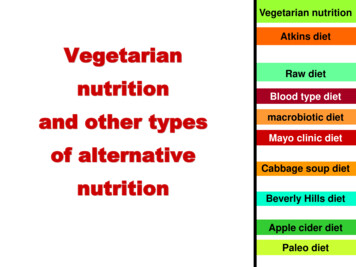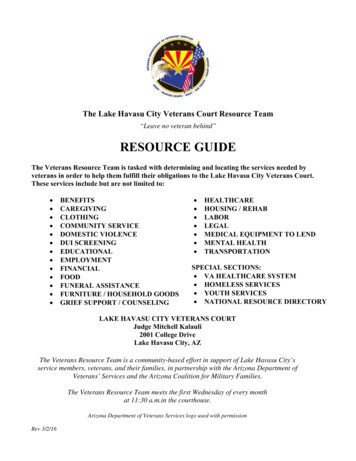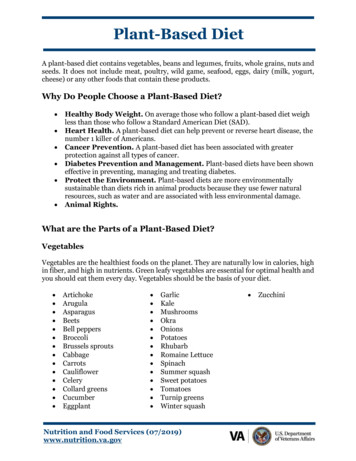
Transcription
Plant-Based DietA plant-based diet contains vegetables, beans and legumes, fruits, whole grains, nuts andseeds. It does not include meat, poultry, wild game, seafood, eggs, dairy (milk, yogurt,cheese) or any other foods that contain these products.Why Do People Choose a Plant-Based Diet? Healthy Body Weight. On average those who follow a plant-based diet weighless than those who follow a Standard American Diet (SAD).Heart Health. A plant-based diet can help prevent or reverse heart disease, thenumber 1 killer of Americans.Cancer Prevention. A plant-based diet has been associated with greaterprotection against all types of cancer.Diabetes Prevention and Management. Plant-based diets have been showneffective in preventing, managing and treating diabetes.Protect the Environment. Plant-based diets are more environmentallysustainable than diets rich in animal products because they use fewer naturalresources, such as water and are associated with less environmental damage.Animal Rights.What are the Parts of a Plant-Based Diet?VegetablesVegetables are the healthiest foods on the planet. They are naturally low in calories, highin fiber, and high in nutrients. Green leafy vegetables are essential for optimal health andyou should eat them every day. Vegetables should be the basis of your diet. ArtichokeArugulaAsparagusBeetsBell peppersBroccoliBrussels sproutsCabbageCarrotsCauliflowerCeleryCollard greensCucumberEggplant e LettuceSpinachSummer squashSweet potatoesTomatoesTurnip greensWinter squashNutrition and Food Services (07/2019)www.nutrition.va.gov Zucchini
Beans and LegumesBeans are a great source of healthy protein and carbohydrate. They contain lots of fiberand resistant starch, which help fill you up and prevent you from absorbing 100% of thecalories in beans. Canned beans are ok – look for low-sodium and reduced-sodiumoptions. AdzukiBlack beansBlack-eyed peasCannelliniChick peas(garbanzo) Dark red kidneysGreat northernLight red kidneysLima beansMungPinto Fava beansNavy beansSoy beans(edamame)LentilsFruitFruit is an excellent source of fiber, water, vitamins, and minerals. It is a healthy sourceof carbohydrates. You should include at least 3 servings of fruit per day. Try purchasingfrozen fruit which is less expensive and won’t go bad. ApplesBananasOrangesKiwiPineappleStrawberries Cantaloupe WatermelonHoneydewNectarinesPeachesPearsPlumsWhole GrainsWhole grains are a great source of fiber and are satisfying and filling. Whole grains thatare in their natural form contain the most nutrition and fiber. Enjoy these whole grainsalongside different beans and vegetables. OatsBrown RiceQuinoaBarleyBulgur AmaranthKamutKashaMilletRye berriesNutrition and Food Services (07/2019)www.nutrition.va.gov Wheat berriesSpeltTeff
Other GrainsProcessed grains can contribute to nutrition and fiber however to a lesser extent. Whenbuying these products make sure the first ingredient is whole grain or whole wheat andthere is at least 3 g fiber per serving. 100% whole wheat bread, tortillas, English muffin100% Whole grain crackersUnsweetened CerealsRefined grains are highly processed and often are stripped of their nutrition and fiber.Avoid these foods as much as possible. White bread, tortillas, bagels and crackersSugary cerealsCandy bars, snack cakes, pastries and cookiesSugary breakfast and granola barsNuts and Seeds Nuts and seeds are the best sources of fat because they also provide fiber, vitamins, &minerals. The eating of nuts is associated with longevity.Eat as a snack, sprinkle on salads, add to smoothies, or use as a base to make yourown healthy dressings.Aim for 1-2 ounces of nuts daily.A 1 ounce serving is 20-24 almonds, 10-14 walnut halves, 18-20 pecans, 16-18cashews, 30-34 peanuts, 2 Tbsp. peanut butter or any nut butter.Flaxseed, chia seeds, and walnuts are particularly good sources of omega-3 fattyacids.Buy ground flaxseed or put flaxseeds or chia seeds in smoothies for greatestnutritional benefit. PeanutsPeanut butterAlmondsAlmond butterPistachiosBrazil nuts CashewsChestnutsHazelnutsMacadamia nutsPecansPine nutsNutrition and Food Services (07/2019)www.nutrition.va.gov WalnutsFlaxseedPumpkin seedsChia seedsSesame seedsSunflower seeds
Alternative Protein SourcesIn addition to getting protein from beans, nuts, seeds and certain whole grains andvegetables, the following protein sources can replace the meat portion of your plate. Tofu is made from cooked soybeans. It has a mild nutty taste that takes on theflavor of the food with which it’s cooked. Firm and extra-firm tofu are goodreplacements for meat dishes. Silken tofu is great for adding to soups, sauces andsmoothies. Pre-baked flavored tofu is a quick option which can be added to saladsand meals. Tempeh is a soybean patty made by fermenting cooked soybeans. It has a nuttyflavor and a firmer texture than tofu. It quickly absorbs the flavors of which it iscooked. You may also find tempeh pre-marinated and in strips which isconvenient for wraps, sandwiches, stir-fry, stews or salads. Seitan is gluten, the protein portion of wheat. It has a chewy texture like chickenor turkey. Seitan can be found pre-flavored and a great addition to stews, curriesand roasts. If you have celiac disease or gluten-sensitivity, then you should avoidseitan. Textured Vegetable Protein (TVP) is isolated soy protein with the texture ofground meat or turkey. It can be used when making chili, stews, meat sauce andtacos. This is a dry product and takes only a few minutes to reconstitute beforeseasoning and cooking. Meat Substitutes often called “faux meat” include a large range of productswhich imitate the texture and taste of ground meat, bacon, meatballs, sausage,chicken, chicken patties and more.Snacks Fresh fruit or unsweetened dried or packaged fruit (applesauce, fruit cups)Nuts, nut butter, or seedsVegetables (baby carrots, cauliflower, bell peppers, radishes, broccoli, snap peas,celery) or pretzels with hummusEdamameAir-popped popcorn, kettle corn (try with nutritional yeast)Bars made with only whole ingredientsUnsweetened cereal with plant-based milkWhole grain English muffin topped with avocado and tomatoSee the “Plant-Based Snacks” handout for more ideas!Nutrition and Food Services (07/2019)www.nutrition.va.gov
BeveragesThe best beverage to drink is water. Other healthful options include: Unsweetened tea (black, green, hibiscus) Carbonated water Black coffeeReplace dairy milks with non-dairy milks such as almond, soy, coconut, cashew, rice, flax,macadamia, or oat.Choose whole fruits and vegetables over 100% fruit and/or vegetable juices to maximizeyour intake of vitamins, minerals and fiber.Avoid sweetened beverages as they only provide empty calories. Soda Sports Drinks Sweet tea Energy Drinks Fruit drinks AlcoholHow Do You Adopt a Plant-Based Diet? Go Meatless One Day a Week. Pick one day of the week to enjoy foods onlyof plant origin. You may have heard of “Meatless Monday,” the global movementto “once a week, cut the meat.” Originally started during WWI, the goal is toreduce overall meat consumption to promote health of humans and the planet. Begin with Breakfast. Make your most important meal of the day plant-based: Oatmeal or quinoa with fruits, nuts and seeds Green smoothies (leafy greens, vegetables, frozen or fresh fruit, non-dairymilk, nuts, seeds) Unsweetened cereals with non-dairy milk topped with fruit 100% whole wheat bread with nut butter and fruit Tofu scramble with beans and baked sweet potato home fries Plant-Based Until Dinner. Add a plant-based power lunch to your agenda: Large salad with your favorite greens, vegetables, beans, nuts, seeds andfruits with a low-fat vinaigrette dressing Vegetable and bean-based soups, stews or chilis Veggie wrap with hummus or nut butter and fruit sandwich Jump Right In. For those who are ready to go cold “tofurkey” and transition toa fully plant-based diet, grab this handout and head to your grocery store!Nutrition and Food Services (07/2019)www.nutrition.va.gov
Plant-Based Food Guide PyramidNutrition and Food Services (07/2019)www.nutrition.va.gov
Plant-Based Diet Nutrition and Food Services (07/2019) www.nutrition.va.gov A plant-based diet contains vegetables, beans and legumes, fruits, whole grains, nuts and seeds. It does not include meat, poultry, wild game, seafood, eggs, dairy (milk, yogurt, cheese) or any other foods that conta

